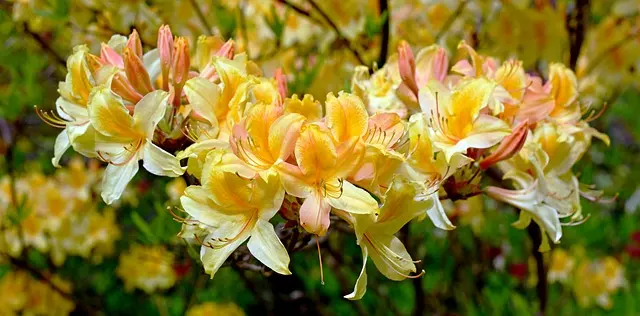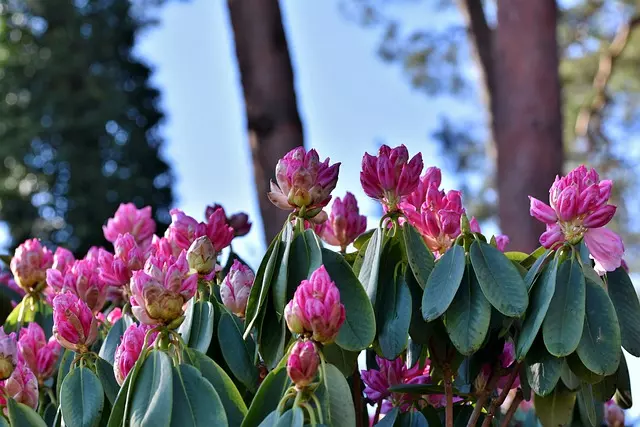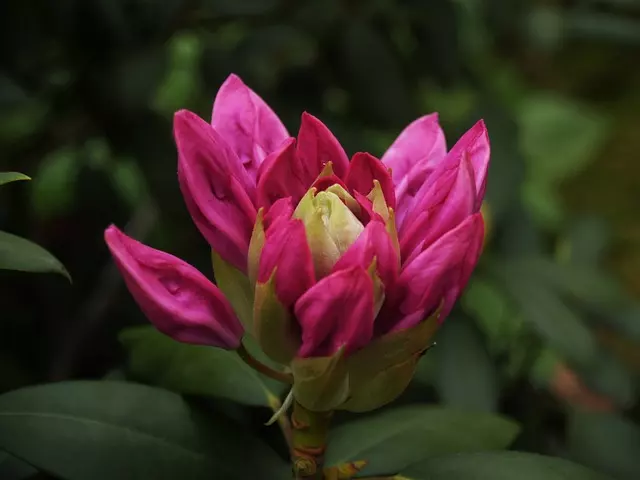Rhododendrons are perennial shrubs that beautify our gardens. If you notice yellow leaves on rhododendrons, there may be a problem. Do not worry. This has a solution. First, you should understand why rhododendron leaves turn yellow and the causes behind yellowing leaves. Moreover, this article summarizes how to treat yellow leaves on Rhododendrons.
Table of Contents
What Causes Yellow Leaves on Rhododendrons
Let’s start with a common question from gardeners, Why are my Rhododendron leaves turning yellow? Let’s see the causes behind yellowing leaves.
What Causes Yellow Leaves on Rhododendrons? Several factors can cause yellow leaves on rhododendrons. For example, it can be a problem of excess water or lack of water.
Rhododendron leaves yellowing. Also, if the plant suffers some stress that may cause yellow leaves, the main thing is to know how to differentiate the problem so we can start the appropriate treatment and thus save our rhododendron plant.
Did the yellow leaves appear before or after the rhododendron bloomed? There is some care that rhododendrons require due to their abundant flowering and the acid pH of the soil they need that we must be sure to provide the plant to prevent their leaves from turning yellow or brown and get an abundant flowering. So let’s review some rhododendron care tips to fix yellowing leaves.
How to Fix Yellow Leaves on Rhododendrons
How do you treat yellow leaves on Rhododendrons due to nutrient deficiencies? A lack of nutrients affects flowering. So if a decrease in flowering accompanies the appearance of yellow leaves, it indicates a nutrient deficiency in the plant.
When does the rhododendron bloom? As there are many varieties of rhododendrons, the flowering period varies. However, the best-known and most widely planted species bloom in spring (April and May). Sometimes it is easy to find rhododendron leaves turning yellow after blooming because of a lack of nutrients.
How to Fix Yellow Leaves on Rhododendrons? Before full flowering, remember to add liquid fertilizer along with the water or the granulated fertilizers mentioned below, which facilitates the slow release of the nutrients. Fertilizing Rhododendrons during springtime will also improve blooming. This is a suitable fertilizer for fixing yellowing leaves on Rhododendrons.
- 14-7-7
- No mixing required
- Slow release
Yellow Leaves on Rhododendrons Due to Excess Light
Rhododendron leaves yellowing due to Excess Light. It is one of the most important rhododendrons care. Although it needs good sun exposure, it does not tolerate direct sunlight. Rhododendrons thrive best in semi-shade or, failing that, in a site that receives sunlight during off-peak hours.
Rhododendron leaves turn yellow due to sun exposure. Sunlight tends to discolor exposed leaves. When this happens, adding nitrogen helps the leaves turn green again.
To avoid this problem, we must choose the right place to plant our rhododendron. This can be in a place with some shade or where it gets sunlight at off-peak hours.

Extreme Temperatures the Enemy of Rhododendrons
Rhododendron leaves yellowing due to high temperatures. Extreme Temperatures the Enemy of Rhododendrons. The excess of cold or heat is something that we will have to consider seriously in the care of the rhododendron.
Although it is not a demanding plant in terms of climate and is easily adapted to them, it is necessary to be vigilant if we live in a place of extremes.
But make no mistake. Rhododendron is part of the list of cold-hardy shrubs for the garden. However, you need to be cautious and plant it sheltered from frost.
If this is impossible, mulch it with mulch or dry leaves during the harsh winter months. Prevention is better than figuring out how to recover a plant after a frost.
Yellow Leaves on Rhododendron Due to Excess Water
Yellow Leaves on Rhododendrons Due to Excess Water. Just as we will have to decide where to plant it, spending a little more time on drainage is essential.
Are Rhododendron leaves turning yellow due to Due to Excess Water? Despite being a water-loving plant, the rhododendron does not tolerate excess water in its roots. What’s more, exposing it to that extra water will only result in the death of the plant.
Without good drainage, you will have yellow leaves on rhododendrons. Ensure the soil is adequate; if it does not have good drainage, you can add clay pellets or perlite to improve it.

Acid Soil, One of The Rhododendron Care Vital for Its Development
Acid Soil, One of The Rhododendrons Care Vital for Its Development. A detail is even more important than the planting site. Only if we provide our shrub with acid soil will it be able to thrive and, more importantly, bloom. The rhododendron can only unfold its flower clusters if it has the necessary ferric nutrients.
If you do not know the composition of the soil, you can prepare acid soil with the pH required by this plant. It will be enough to provide natural fertilizer or mineral fertilizers regularly.
Fertilizing regularly to bring the acid pH in the soil is crucial for developing rhododendrons. Otherwise, you will see yellow leaves on rhododendrons due to nutritional deficiency, especially at blooming time.
Acid pH peat. To avoid future problems and further root development, the peat must be of acid pH, so we must plan well which substrate to buy. We can find different substrates for acidic plants that harbor nutrients for their initial development.
The soil pH of this type of peat is usually around 5-5.5, and it is beneficial for rhododendrons to fix yellow leaves.
As this perennial plant grows, we must either transplant it to the garden or adapt it to a larger pot. The first example is the most complicated since the post-transplant shock is worse. The soil has different drainage, pH, texture, hardness, etc.
A tip is to make abundant irrigation just after the transplant, with a small contribution of nutrients so that the roots that could have been damaged heal well and the emission of new ones occurs. Of course, it is essential to maintain proper drainage.
Yellow Leaves on Rhododendrons Due to Chlorosis
Rhododendron Leaves Turning Yellow Due to Chlorosis. When the leaves are yellow, but the region along the veins remains dark green, the plant probably suffers from chlorosis.
When chlorosis affects Rhododendrons, there is a characteristic deficiency of magnesium, nitrogen, or iron. In this case, the soil pH should be checked.
Recommended article: How to measure soil pH
Rhododendron is a species accustomed to slightly acid soils. Lime and high-pH soils tend to cause iron chlorosis.
If your garden has a high pH, you must provide a liquid iron chelate at the beginning of spring, which will be reapplied at the recommended dose in summer at the time of maximum splendor.
The soil must have good drainage conditions, which can help you with the contribution of organic matter.
Before planting, mixing the extracted soil with organic matter or compost in equal parts in the hole is advisable. This simple technique will allow faster development of the rhododendron roots and enough nutrients for its first flowering.
A very high pH hinders the plant’s ability to absorb trace metals. If the pH is close to 5.5, it is recommended to add Epsom salts. If this does not work, adding a source of nitrogen and chelated iron is useful. Recommended articles to learn how to treat and fix iron deficiencies. Iron Sulfate for Plants: What It Is And How to Use It and Iron Deficiency in Plants – Ultimate Guide
The yellowing of young Rhododendron leaves with characteristic green veins is a clear sign of iron deficiency. It is widespread in plants accustomed to acidic environments but planted in alkaline or high-pH soils.
The solution is to apply any iron corrector in chelate, which allows iron to be stable at different pH ranges.
Chlorotic yellow leaves are often a sign of iron deficiency and can be treated using an iron sequence. Overfertilization should be avoided, as the leaf margin will likely dry and brown.
Yellow leaves on Rhododendrons due to chlorosis is a persistent cause that should not be overlooked. Lack of nutrients and soil acidity, necessary for rhododendron thrives, are the two most frequent causes of rhododendron leaves turning yellow.

Next, we will see a last reason that causes yellow leaves in Rhododendrons and a cause that causes brown or brownish leaves in Rhododendrons. Also, we will see how to solve these common problems in rhododendron leaves from both situations.
Rhododendron Leaf Drop and Rhododendron Lower Leaves Yellowing
Rhododendron Leaf Drop and Rhododendron Lower Leaves Yellowing. The fall of leaves that are not visually affected for any reason is a natural consequence of rhododendron growth, which replaces the lower leaves with the production of new leaves from the upper shoots.
Rhododendron Brown Leaves
Rhododendron Brown Leaves. When rhododendrons have excess moisture in the soil or substrate (especially in pot culture), the lack of oxygen to the roots causes slow and continuous rotting of the leaves.
An initial process is the loss of chlorophyll, resulting in a generic yellowing of the plant, but with a wrinkled and weak appearance of the leaves, which fall almost under their weight.
As the days go by, these leaves become very flaccid and brown. A natural hormone known as ethylene is released, and the leaves fall to the ground.
Recommended article: How To Care for Rhododendrons – Guide


